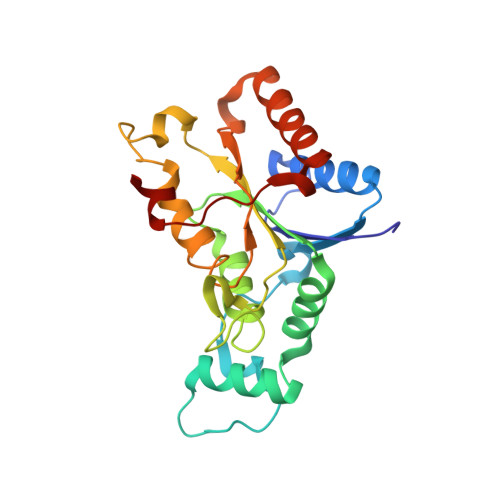In silico screening reveals structurally diverse, nanomolar inhibitors of NQO2 that are functionally active in cells and can modulate NF-kappa B signaling.
Nolan, K.A., Dunstan, M.S., Caraher, M.C., Scott, K.A., Leys, D., Stratford, I.J.(2012) Mol Cancer Ther 11: 194-203
- PubMed: 22090421
- DOI: https://doi.org/10.1158/1535-7163.MCT-11-0543
- Primary Citation of Related Structures:
3TZB - PubMed Abstract:
The National Cancer Institute chemical database has been screened using in silico docking to identify novel nanomolar inhibitors of NRH:quinone oxidoreductase 2 (NQO2). The inhibitors identified from the screen exhibit a diverse range of scaffolds and the structure of one of the inhibitors, NSC13000 cocrystalized with NQO2, has been solved. This has been used to aid the generation of a structure-activity relationship between the computationally derived binding affinity and experimentally measured enzyme inhibitory potency. Many of the compounds are functionally active as inhibitors of NQO2 in cells at nontoxic concentrations. To show this, advantage was taken of the NQO2-mediated toxicity of the chemotherapeutic drug CB1954. The toxicity of this drug is substantially reduced when the function of NQO2 is inhibited, and many of the compounds achieve this in cells at nanomolar concentrations. The NQO2 inhibitors also attenuated TNFα-mediated, NF-кB-driven transcriptional activity. The link between NQO2 and the regulation of NF-кB was confirmed by using short interfering RNA to NQO2 and by the observation that NRH, the cofactor for NQO2 enzyme activity, could regulate NF-кB activity in an NQO2-dependent manner. NF-кB is a potential therapeutic target and this study reveals an underlying mechanism that may be usable for developing new anticancer drugs.
Organizational Affiliation:
School of Pharmacy and Pharmaceutical Sciences, University of Manchester and Manchester Cancer Research Centre, Manchester M13 9PT, United Kingdom.






















